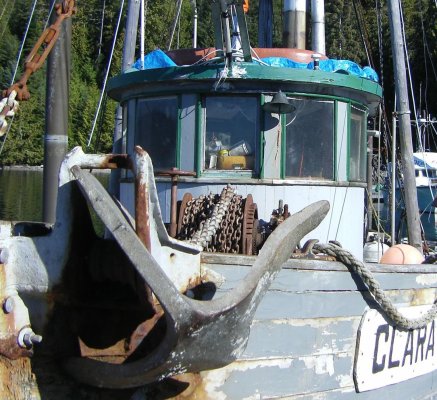Eric--- I totally agree with your and Rex's notion of "laying" an anchor down when deploying it vs. dropping it to the bottom with a big pile of chain on top. And I believe one can "feel" the deployment with an electric windlass almost as well as you can by hand.
When we deploy our anchor I operate the windlass at the windlass as opposed to using a remote control from the helm. My wife operates the boat and we communicate with hand signals and an intercom/hailer. I do this because I can watch the chain go out, I can see the amount of pull using the change in catenary as a guide, and if I want to I can put my hand on the chain and feel what it is doing. By being out of the cabin up on the bow I am in a better position to judge our boat's rearward movement---or lack of it--- using the relative movement between things on shore while at the same time seeing and feeling what the chain is doing in relationship to the anchor.
We do the same thing when retrieving the anchor. By being right beside the windlass and chain I can judge the amount of strain being put on the system, I can keep pace with the windlass to match the slow forward creep of the boat to keep the chain from angling back into the hull, I can hear how hard the windlass is working, and I can determine if the anchor is breaking out easily or needs to be snubbed off with our heavy setting line and broken out with the boat.
I would not waste bandwidth trying to convince me to put our Bruce back on the boat. I am completely convinced by direct experience reinforced by more and more user testimonials I hear or read that in small sizes it is a very poor anchor design in terms of holding and we would never have one again on any boat. Not when there are designs out there now that are clearly so superior, one of which we already have. After our (and friends') experiences with it the Bruce/Claw is a total non-starter in our book and we no longer consider it a viable anchor design, at least in the small sizes and weights dictated by boats our size.
If it makes you feel any better we feel exactly the same about the CQR although for different reasons. However our bias against the CQR is
not based on any experience with it whatsoever, but simply by looking at its design. So it's a totally armchair-theory bias.

I understand the principle behind the CQR but an anchor that is streamlined in the direction of pull is a design looking for a reason to fail to my way of thinking.
In our opinion and based on our experience over the last seven years there is currently only one type of anchor for all-round use in a wide variety of bottoms in the sizes we require that is worth considering and that is the rollbar anchor. We can debate the merits of concave vs. convex fluke and slotted vs non-slotted shank and so forth, but the bottom line is that we believe the rollbar design represents the best performing small anchor to date.
Now if one anchors in the same basic conditions all the time, like the mud that I understand is the predominant bottom in the SFO Bay/Delta region in California, an anchor that is proven to do extremely well in this kind of bottom would make all kinds of sense, too.
Our boat, which spent its whole life in SFO Bay until we liberated it, came with heavy Danforth-type anchors bow and stern, which made perfect sense. Had we kept the boat in the bay we probably would have retained this type of anchor as I don't know that a rollbar anchor (which we had not even heard of at the time) would have proven any more effective.
The only part of the puzzle yet to be resolved in my mind is the Rocna vs Sarca question. I prefer the concave fluke of the Rocna because logic tells me that it will resist movement through the bottom better than a convex fluke. But again, that's an armchair theory, not one based on any experience other than using a shovel. But the Sarca's fluke is not really all that convex. So it would be very interesting to compare the two in identical sizes over a long period of time and variety of anchoring conditions. (The amount of mud brought up by an anchor is not anything I care about because we can easily deal with it on our boat).
The Sarca was not an option when we bought our anchor so whether it's better, the same, or worse than a Rocna would not have been a factor in our purchase decision at the time. But these two anchors are really, really clever, I think, and I admire and congratulate the folks who put the thought and effort into their creation.

